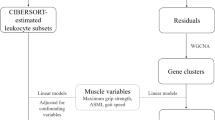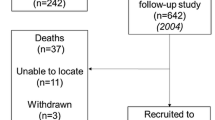Abstract
Sarcopenia is associated with adverse health outcomes. This study investigated whether skeletal muscle gene expression was associated with lean mass and grip strength in community-dwelling older men. Utilising a cross-sectional study design, lean muscle mass and grip strength were measured in 88 men aged 68–76 years. Expression profiles of 44 genes implicated in the cellular regulation of skeletal muscle were determined. Serum was analysed for circulating cytokines TNF (tumour necrosis factor), IL-6 (interleukin 6, IFNG (interferon gamma), IL1R1 (interleukin-1 receptor-1). Relationships between skeletal muscle gene expression, circulating cytokines, lean mass and grip strength were examined. Participant groups with higher and lower values of lean muscle mass (n = 18) and strength (n = 20) were used in the analysis of gene expression fold change. Expression of VDR (vitamin D receptor) [fold change (FC) 0.52, standard error for fold change (SE) ± 0.08, p = 0.01] and IFNG mRNA (FC 0.31; SE ± 0.19, p = 0.01) were lower in those with higher lean mass. Expression of IL-6 (FC 0.43; SE ± 0.13, p = 0.02), TNF (FC 0.52; SE ± 0.10, p = 0.02), IL1R1 (FC 0.63; SE ± 0.09, p = 0.04) and MSTN (myostatin) (FC 0.64; SE ± 0.11, p = 0.04) were lower in those with higher grip strength. No other significant changes were observed. Significant negative correlations between serum IL-6 (R = −0.29, p = 0.005), TNF (R = −0.24, p = 0.017) and grip strength were demonstrated. This novel skeletal muscle gene expression study carried out within a well-characterized epidemiological birth cohort has demonstrated that lower expression of VDR and IFNG is associated with higher lean mass, and lower expression of IL-6, TNF, IL1R1 and myostatin is associated with higher grip strength. These findings are consistent with a role of proinflammatory factors in mediating lower muscle strength in community-dwelling older men.


Similar content being viewed by others
References
Patel HP, Syddall HE, Jameson K, Robinson S, Denison H, Roberts HC, Edwards M, Dennison E, Cooper C, Aihie Sayer A (2013) Prevalence of sarcopenia in community-dwelling older people in the UK using the European Working Group on Sarcopenia in Older People (EWGSOP) definition: findings from the Hertfordshire Cohort Study (HCS). Age Ageing 42:378–384
Cruz-Jentoft AJ, Baeyens JP, Bauer JM, Boirie Y, Cederholm T, Landi F, Martin FC, Michel JP, Rolland Y, Schneider SM, Topinkova E, Vandewoude M, Zamboni M (2010) Sarcopenia: European consensus on definition and diagnosis: Report of the European Working Group on Sarcopenia in Older People. Age Ageing 39:412–423
Newman AB, Haggerty CL, Goodpaster B, Harris T, Kritchevsky S, Nevitt M, Miles TP, Visser M (2003) Strength and muscle quality in a well-functioning cohort of older adults: The Health, Aging and Body Composition Study. J Am Geriatr Soc 51:323–330
Grounds MD (2002) Reasons for the degeneration of ageing skeletal muscle: a central role for IGF-1 signalling. Biogerontology 3:19–24
Meng SJ, Yu LJ (2010) Oxidative stress, molecular inflammation and sarcopenia. Int J Mol Sci 11:1509–1526
Goodman CA, Mayhew DL, Hornberger TA (2011) Recent progress toward understanding the molecular mechanisms that regulate skeletal muscle mass. Cell Signal 23:1896–1906
Roubenoff R, Parise H, Payette HA, Abad LW, D’Agostino R, Jacques PF, Wilson PW, Dinarello CA, Harris TB (2003) Cytokines, insulin-like growth factor 1, sarcopenia, and mortality in very old community-dwelling men and women: The Framingham Heart Study. Am J Med 115:429–435
Gumucio JP, Mendias CL (2013) Atrogin-1, MuRF-1, and sarcopenia. Endocrine 43:12–21
Christakos S, Hewison M, Gardner DG, Wagner CL, Sergeev IN, Rutten E, Pittas AG, Boland R, Ferrucci L, Bikle DD (2013) Vitamin D: beyond bone. Ann N Y Acad Sci 1287:45–58
Huang Z, Chen X, Chen D (2011) Myostatin:a novel insight into its role in metabolism, signal pathways and expression regulation. Cell Signall 23:1441–1446
Lee SJ, McPherron AC (2001) Regulation of myostatin activity and muscle growth. Proc Natl Acad Sci U S A 98:9306–9311
Boland RL (2011) VDR activation of intracellular signaling pathways in skeletal muscle. Mol Cell Endocrinol 347:11–16
Ceglia L (2008) Vitamin D and skeletal muscle tissue and function. Mol Asp Med 29:407–414
Endo I, Inoue D, Mitsui T, Umaki Y, Akaike M, Yoshizawa T, Kato S, Matsumoto T (2003) Deletion of vitamin D receptor gene in mice results in abnormal skeletal muscle development with deregulated expression of myoregulatory transcription factors. Endocrinology 144:5138–5144
Song Y, Kato S, Fleet JC (2003) Vitamin D receptor (VDR) knockout mice reveal VDR-independent regulation of intestinal calcium absorption and ECaC2 and calbindin D9k mRNA. J Nutr 133:374–380
Roth SM, Zmuda JM, Cauley JA, Shea PR, Ferrell RE (2004) Vitamin D receptor genotype is associated with fat-free mass and sarcopenia in elderly men. J Gerontol A Biol Sci Med Sci 59:10–15
McPherron AC, Lawler AM, Lee SJ (1997) Regulation of skeletal muscle mass in mice by a new TGF-beta superfamily member. Nature 387:83–90
Kambadur R, Sharma M, Smith TP, Bass JJ (1997) Mutations in myostatin (GDF8) in double-muscled Belgian Blue and Piedmontese cattle. Genome Res 7:910–916
Constantin D, McCullough J, Mahajan RP, Greenhaff PL (2011) Novel events in the molecular regulation of muscle mass in critically ill patients. J Physiol 589:3883–3895
Gonzalez-Cadavid NF, Taylor WE, Yarasheski K, Sinha-Hikim I, Ma K, Ezzat S, Shen R, Lalani R, Asa S, Mamita M, Nair G, Arver S, Bhasin S (1998) Organization of the human myostatin gene and expression in healthy men and HIV-infected men with muscle wasting. Proc Natl Acad Sci U S A 95:14938–14943
Allen DL, Loh AS (2011) Posttranscriptional mechanisms involving microRNA-27a and b contribute to fast-specific and glucocorticoid-mediated myostatin expression in skeletal muscle. Am J Physiol Cell Physiol 300:C124–C137
Lokireddy S, Wijesoma IW, Bonala S, Wei M, Sze SK, McFarlane C, Kambadur R, Sharma M (2012) Myostatin is a novel tumoral factor that induces cancer cachexia. Biochem J 446:23–36
Beyer I, Mets T, Bautmans I (2012) Chronic low-grade inflammation and age-related sarcopenia. Curr Opin Clin Nutr Metab Care 15:12–22
Schaap LA, Pluijm SM, Deeg DJ, Harris TB, Kritchevsky SB, Newman AB, Colbert LH, Pahor M, Rubin SM, Tylavsky FA, Visser M (2009) Higher inflammatory marker levels in older persons: associations with 5-year change in muscle mass and muscle strength. J Gerontol A Biol Sci Med Sci 64:1183–1189
Visser M, Pahor M, Taaffe DR, Goodpaster BH, Simonsick EM, Newman AB, Nevitt M, Harris TB (2002) Relationship of interleukin-6 and tumor necrosis factor-alpha with muscle mass and muscle strength in elderly men and women: The Health ABC Study. J Gerontol A Biol Sci Med Sci 57:M326–M332
Barns M, Gondro C, Tellam RL, Radley-Crabb HG, Grounds MD, Shavlakadze T (2014) Molecular analyses provide insight into mechanisms underlying sarcopenia and myofiber denervation in old skeletal muscles of mice. Int J Biochem Cell Biol 13(53C):174–185
Liu D, Sartor MA, Nader GA, Pistilli EE, Tanton L, Lilly C, Gutmann L, IglayReger HB, Visich PS, Hoffman EP, Gordon PM (2013) Microarray analysis reveals novel features of the muscle aging process in men and women. J Gerontol A Biol Sci Med Sci 68:1035–1044
Patel HP, Syddall HE, Martin HJ, Stewart CE, Cooper C, Sayer AA (2010) Hertfordshire Sarcopenia Study: design and methods. BMC Geriatr 10:43
Syddall HE, Sayer AA, Dennison EM, Martin HJ, Barker DJ, Cooper C (2005) Cohort profile: The Hertfordshire cohort study. Int J Epidemiol 34:1234–1242
Livak KJ, Schmittgen TD (2001) Analysis of relative gene expression data using real-time quantitative PCR and the 2(-Delta Delta C(T)) Method. Methods 25:402–408
Tichopad A, Pecen L, Pfaffl MW (2006) Distribution-insensitive cluster analysis in SAS on real-time PCR gene expression data of steadily expressed genes. Comput Methods Progr Biomed 82:44–50
Huang DW, Sherman BT, Tan Q, Kir J, Liu D, Bryant D, Guo Y, Stephens R, Baseler MW, Lane HC, Lempicki RA (2007) DAVID bioinformatics resources: expanded annotation database and novel algorithms to better extract biology from large gene lists. Nucleic Acids Res 35:W169–W175
Goodpaster BH, Park SW, Harris TB, Kritchevsky SB, Nevitt M, Schwartz AV, Simonsick EM, Tylavsky FA, Visser M, Newman AB (2006) The loss of skeletal muscle strength, mass, and quality in older adults: the health, aging and body composition study. J Gerontol A Biol Sci Med Sci 61:1059–1064
Leger B, Derave W, De BK, Hespel P, Russell AP (2008) Human sarcopenia reveals an increase in SOCS-3 and myostatin and a reduced efficiency of Akt phosphorylation. Rejuvenation Res 11:163–175B
Rieu I, Magne H, Savary-Auzeloux I, Averous J, Bos C, Peyron MA, Combaret L, Dardevet D (2009) Reduction of low grade inflammation restores blunting of postprandial muscle anabolism and limits sarcopenia in old rats. J Physiol 587:5483–5492
Bartali B, Frongillo EA, Stipanuk MH, Bandinelli S, Salvini S, Palli D, Morais JA, Volpato S, Guralnik JM, Ferrucci L (2012) Protein intake and muscle strength in older persons: does inflammation matter? J Am Geriatr Soc 60:480–484
Londhe P, Davie JK (2011) Gamma interferon modulates myogenesis through the major histocompatibility complex class II transactivator, CIITA. Mol Cell Biol 31:2854–2866
Schroder K, Hertzog PJ, Ravasi T, Hume DA (2004) Interferon-gamma: an overview of signals, mechanisms and functions. J Leukoc Biol 75:163–189
Cheng M, Nguyen MH, Fantuzzi G, Koh TJ (2008) Endogenous interferon-gamma is required for efficient skeletal muscle regeneration. Am J Physiol Cell Physiol 294:C1183–C1191
Barreiro E, Schols AM, Polkey MI, Galdiz JB, Gosker HR, Swallow EB, Coronell C, Gea J (2008) Cytokine profile in quadriceps muscles of patients with severe COPD. Thorax 63:100–107
Rayavarapu S, Coley W, Nagaraju K (2011) An update on pathogenic mechanisms of inflammatory myopathies. Curr Opin Rheumatol 23:579–584
Crescioli C, Sottili M, Bonini P, Cosmi L, Chiarugi P, Romagnani P, Vannelli GB, Colletti M, Isidori AM, Serio M, Lenzi A, Di LL (2012) Inflammatory response in human skeletal muscle cells: CXCL10 as a potential therapeutic target. Eur J Cell Biol 91:139–149
Chen S, Law CS, Grigsby CL, Olsen K, Hong TT, Zhang Y, Yeghiazarians Y, Gardner DG (2011) Cardiomyocyte-specific deletion of the vitamin D receptor gene results in cardiac hypertrophy. Circulation 124:1838–1847
Han DS, Chen YM, Lin SY, Chang HH, Huang TM, Chi YC, Yang WS (2011) Serum myostatin levels and grip strength in normal subjects and patients on maintenance haemodialysis. Clin Endocrinol (Oxf) 75:857–863
Whittemore LA, Song K, Li X, Aghajanian J, Davies M, Girgenrath S, Hill JJ, Jalenak M, Kelley P, Knight A, Maylor R, O’Hara D, Pearson A, Quazi A, Ryerson S, Tan XY, Tomkinson KN, Veldman GM, Widom A, Wright JF, Wudyka S, Zhao L, Wolfman NM (2003) Inhibition of myostatin in adult mice increases skeletal muscle mass and strength. Biochem Biophys Res Commun 300:965–971
Amthor H, Macharia R, Navarrete R, Schuelke M, Brown SC, Otto A, Voit T, Muntoni F, Vrbova G, Partridge T, Zammit P, Bunger L, Patel K (2007) Lack of myostatin results in excessive muscle growth but impaired force generation. Proc Natl Acad Sci U S A 104:1835–1840
Schirwis E, Agbulut O, Vadrot N, Mouisel E, Hourde C, Bonnieu A, Butler-Browne G, Amthor H, Ferry A (2012) The beneficial effect of myostatin deficiency on maximal muscle force and power is attenuated with age. Exp Gerontol 48(2):183–190
Acknowledgment
We are very grateful to the study participants and research staff at the Wellcome Trust Clinical Research Facility, University Hospital Southampton Foundation Trust.
Human and Animal Rights and Informed Consent
This study was ethically approved by the Hertfordshire Research Ethics Committee (Hertfordshire, UK) and performed in accordance with the criteria defined by the rules of the committee.
Author information
Authors and Affiliations
Corresponding author
Additional information
The authors declare that they have no conflict of interest.
Electronic supplementary material
Below is the link to the electronic supplementary material.
Rights and permissions
About this article
Cite this article
Patel, H.P., Al-Shanti, N., Davies, L.C. et al. Lean Mass, Muscle Strength and Gene Expression in Community Dwelling Older Men: Findings from the Hertfordshire Sarcopenia Study (HSS). Calcif Tissue Int 95, 308–316 (2014). https://doi.org/10.1007/s00223-014-9894-z
Received:
Accepted:
Published:
Issue Date:
DOI: https://doi.org/10.1007/s00223-014-9894-z




